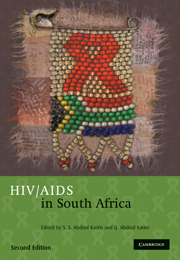Book contents
- Frontmatter
- Contents
- List of Contributors
- Foreword: Peter Piot
- Foreword: Nelson R Mandela
- Acknowledgements
- Section 1 Birth of a rapidly growing epidemic
- Section 2 The virus, the human host and their interactions
- Section 3 HIV risk factors and prevention strategiess
- Section 4 Focal groups for understanding the HIV epidemic
- Section 5 The impact of AIDS
- Section 6 Treating HIV
- Section 7 What does the future hold?
- 33 Models and trends
- 34 The future of the HIV epidemic in South Africa
- Index
34 - The future of the HIV epidemic in South Africa
Published online by Cambridge University Press: 07 September 2011
- Frontmatter
- Contents
- List of Contributors
- Foreword: Peter Piot
- Foreword: Nelson R Mandela
- Acknowledgements
- Section 1 Birth of a rapidly growing epidemic
- Section 2 The virus, the human host and their interactions
- Section 3 HIV risk factors and prevention strategiess
- Section 4 Focal groups for understanding the HIV epidemic
- Section 5 The impact of AIDS
- Section 6 Treating HIV
- Section 7 What does the future hold?
- 33 Models and trends
- 34 The future of the HIV epidemic in South Africa
- Index
Summary
THE HIV EPIDEMIC IN South Africa has evolved over the last 25 years and is now characterised by a levelling off of prevalence rates, amidst persistently high HIV incidence rates. The national incidence rate of HIV infection in antenatal clinic attendees is estimated to have peaked at 6.5% in 1997 and HIV transmission models have suggested that incidence has continued to hover at this level for the past five years. South Africa is now dealing with the full impact of the clinical burden of AIDS and the concomitant deaths that result. The introduction of free antiretroviral therapy in the public sector is a turning point that enables South Africa to purposefully and deliberately choose the future path of the HIV epidemic in this country. Choosing to implement treatment programmes without concomitant prevention interventions will result in an upward trend in the epidemic curve and an evergrowing unsustainable level of demand for antiretroviral therapy. However, South Africa has an opportunity to choose a better future; a future including the integration of HIV treatment and prevention programmes, which will result in a downward trend in the epidemic and our best hope for a bright future for South Africa.
It is well established in many industrialised countries that antiretroviral therapy can transform the natural course of hiv infection by reducing morbidity and mortality. Antiretroviral therapy also symbolises hope for many communities.
- Type
- Chapter
- Information
- HIV/AIDS in South Africa , pp. 585 - 590Publisher: Cambridge University PressPrint publication year: 2010



